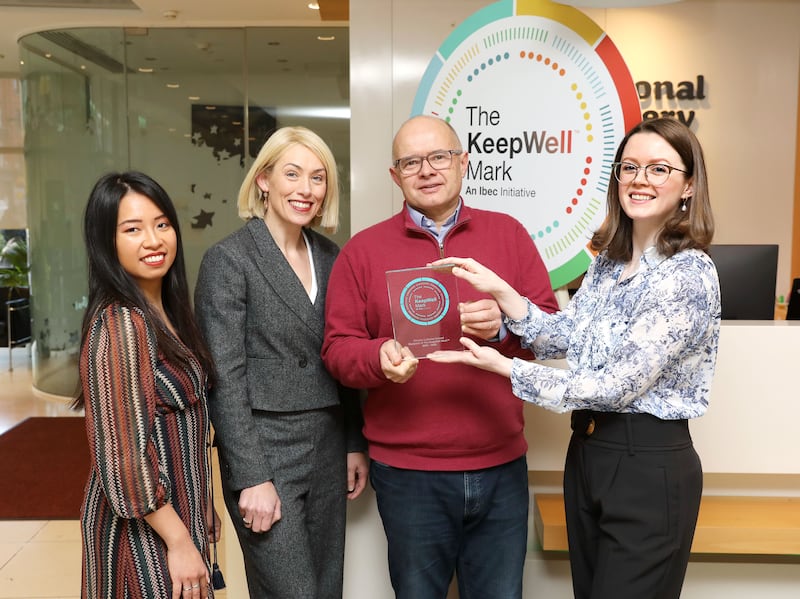Organisations need to take a strategic approach to workplace wellbeing initiatives if they are to make a real difference to employees, according to Ibec KeepWell programme manager Sophie Moran.
“The pandemic taught us that employee wellbeing is of paramount importance for organisational performance,” she says.
“Companies need to think about wellbeing in the same way as they think about any key business area,” Moran adds. “What gets documented gets done. An effective wellbeing strategy needs well-defined objectives and data to underpin those objectives.”
There are no quick fixes or shortcuts to developing a sustainable workplace wellbeing strategy, she points out.
“We sometimes see employers trying to do too much in an effort to be seen to do the right thing,” she says. “That doesn’t work. You need to listen to employees and find out what works for them to help them feel better in themselves. That will have greater impact and much better outcomes.”
Moran advises employers to take a simple approach.
“When you think about physical, financial, mental health, social and other wellbeing areas, it is not necessarily sustainable to address them all. It is better for organisations to pick a few key areas that matter to employees and get them right.
“It is far better to say what you achieved in response to employee needs rather than just produce a record of piecemeal activities that didn’t necessarily achieve anything.”

Organisations can use the Ibec KeepWell Programme to guide them in the development of effective wellbeing strategies. The KeepWell Mark is a national health and wellbeing accreditation awarded by Ibec to recognise organisations’ commitment to employee wellbeing, safety and health.
“It takes a lot of effort for a business to put a wellbeing strategy in place,” says Moran. “The KeepWell Mark recognises that good work.”
Nikki Taggart is an organisational psychologist with Coolehouse Consulting and a KeepWell assessor and consultant.
“Many organisations want to have good wellbeing strategies but are not sure how to go about it,” she says. “They can be well intentioned but actually do damage if not implemented correctly. I’ve worked on a transformation project where a well-intentioned wellbeing initiative ended up causing a lot of pain because it left groups of employees out. It was a 24/7 production operation and shift workers were left out of events.”
She also makes the point that even the very best wellbeing initiatives will not make up for a poor workplace environment or culture.
“The only way a strategy will deliver is if the root causes of the issues facing employees are addressed,” says Taggart. “That means looking at organisation design, the demands placed on people, and the psychosocial pressures employees are under.
“For example, a lot of organisations reduced headcount during the financial crisis meaning that teams were doing even more work than before for less pay. Yoga sessions at lunchtime are not much help there. You do not pass go unless you address the workplace issues first.”

She points to the National Lottery as an example of an organisation that is getting it right.
“It stands out as an organisation which has thought through its strategy and set out a roadmap for what it wants to achieve,” she says.
“We invested quite a lot of time and thought into our people strategy over the past three years,” says National Lottery chief people officer Liz Shouldice. “The outcome of that work has been our inclusion and wellbeing strategy. We want to promote a positive workplace environment and a culture where everyone is welcomed.”
Yoga sessions at lunchtime are not much help there. You do not pass go unless you address the workplace issues first
Relevance to staff is of key importance.
“Wellbeing is very personal,” says employee experience manager Audrey Chew. “A wellbeing programme needs to be multilayered and operate in and out of the workplace and cover mental health, physical health, financial wellbeing, sporting activity and so on. Frameworks like KeepWell help us to see our own blind spots and identify opportunities to expand and improve on.”
The programme continues to evolve.
“We constantly take feedback from our people and listen to how are they feeling, what’s stressing them and so on,” says Shouldice. “We are very responsive to the needs of our staff. That’s what makes the programme stand out. It is quite personalised to each of our 207 staff members.”
Of course, successful wellbeing programmes take time and effort to design and implement.
“In a survey published in the Ibec HR Update Report published in October 2023, 56 per cent of respondents said the key barrier to implementing programmes was lack of time,” says Moran.
“It can be a challenge to devote enough time to wellbeing initiatives. The KeepWell Mark can help. The KeepWell team acts like an extension to the HR team and provide advice and day to day support and guidance. When companies get the KeepWell mark they tend to stick with it and get reaccredited. That’s testament to the value that companies place on the accreditation.”





